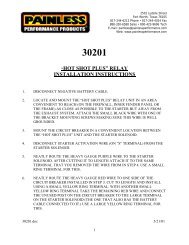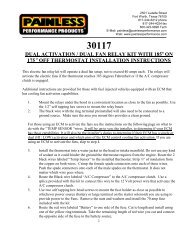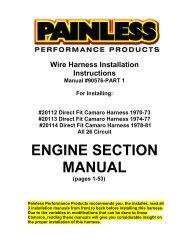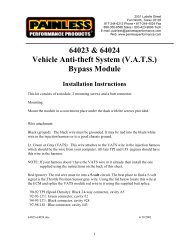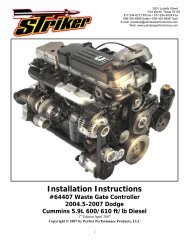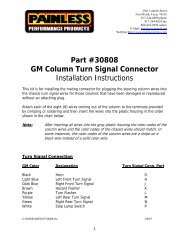WIRE HARNESS INSTALLATION INSTRUCTIONS - Painless Wiring
WIRE HARNESS INSTALLATION INSTRUCTIONS - Painless Wiring
WIRE HARNESS INSTALLATION INSTRUCTIONS - Painless Wiring
You also want an ePaper? Increase the reach of your titles
YUMPU automatically turns print PDFs into web optimized ePapers that Google loves.
8.0 SPECIFIC CIRCUIT CONNECTIONS<br />
8.1 Connecting an Add-On Ammeter and the Maxi-Fuse. See Figure 8-1.<br />
8.1.1 The ammeter must be inserted IN SERIES onto the ENGINE SECTION (single) 10<br />
gauge wire #916 (red) that routes from the fuse panel to the starter solenoid.<br />
8.1.2 The overall physical length of this circuit should be as short as possible (allow<br />
some slack, however). You may have to cut wire #916 and you may have to add<br />
some additional length of 10-gauge wire. USE ONLY 10-GAUGE <strong>WIRE</strong>.<br />
8.1.3 Route wire #916 (from the fuse panel) and connect to the ammeter NEGATIVE<br />
terminal.<br />
8.1.4 Route the remainder of wire #916 from the ammeter POSITIVE terminal to the<br />
starter solenoid battery (B+) terminal. This is the terminal the battery cable is<br />
connected to. Splice the maxi-fuse (Figure 7-2) onto the end of wire #916 and<br />
connect to the starter solenoid battery (B+) terminal.<br />
CAUTION:<br />
CAUTION:<br />
BOTH AMMETER TERMINALS MUST ABSOLUTELY BE ISOLATED FROM<br />
GROUND. IF EITHER AMMETER TERMINAL COMES IN CONTACT WITH<br />
GROUND, A <strong>HARNESS</strong> FIRE IS INEVITABLE. USE EXTREME CARE AND<br />
DILIGENCE IN CONNECTING AMMETERS.<br />
BE SURE YOUR AMMETER'S CURRENT (AMPS) RATING EXCEEDS THE<br />
CURRENT OUTPUT OF YOUR ALTERNATOR. PAINLESS PERFORMANCE<br />
DOES NOT RECOMMEND USING ANY AMMETER RATED AT LESS THAN<br />
65 AMPS. DO NOT USE AN AMMETER WITH ANY HIGH-OUTPUT<br />
ALTERNATOR (MORE THAN 65 AMPS).<br />
Figure 8.1 Ammeter & Maxi-Fuse<br />
8.2 Interior Lighting. See Figure 8-2<br />
8.2.1 Interior lights are switched through the optional door switches and/or the dashmounted<br />
headlight switch, which is usually rotated counter-clockwise to turn on.<br />
These switches apply ground to the circuit. YOU WILL NEED TO SUPPLY THE<br />
GROUND <strong>WIRE</strong>S that go to the door switches. 12V is continually present at the<br />
light bulbs. See Figure 8-2.<br />
8.2.2 If you are using door switches, you will need to add the wires connecting them.<br />
Connect one end of the wire to the door switch and the other end to the ground<br />
wire on the light switch. See Figure 8-2.<br />
11







